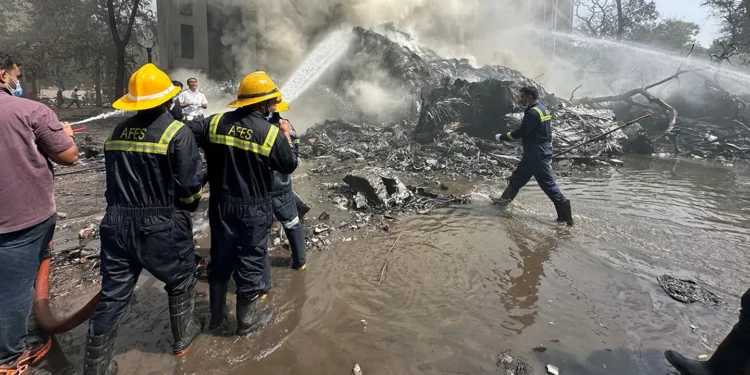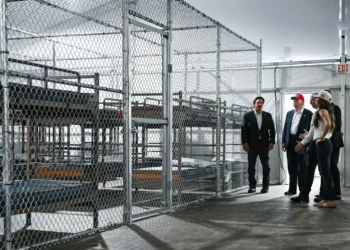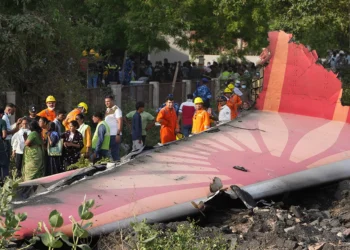Major Plane Crashes in India: A Timeline of Air Disasters (1993-2025)
India’s aviation history has been marked by several tragic accidents over the decades. The recent Air India Boeing 787 crash in Ahmedabad in June 2025 has once again brought attention to aviation safety in the country. This comprehensive timeline examines the major plane crashes in India from 1993 to 2025, detailing the circumstances, casualties, and causes behind these aviation disasters.
2025 Ahmedabad Air India Crash

The Air India Boeing 787 crash site in Ahmedabad, June 2025
On June 12, 2025, Air India Flight 171, a Boeing 787-8 Dreamliner carrying 230 passengers and 12 crew members, crashed shortly after takeoff from Ahmedabad Airport. The aircraft was bound for London Gatwick when it went down in a densely populated residential area near the airport, specifically in the Meghani Nagar district.
According to preliminary reports, the aircraft reached an altitude of only 625 feet before crashing. The disaster claimed 241 lives onboard, with only one survivor found in seat 11A. An additional 24 people on the ground were killed when the aircraft struck a medical college hostel. This marked the first fatal crash involving a Boeing 787 Dreamliner since the aircraft type entered service in 2011.
“The tragedy in Ahmedabad has stunned and saddened us. It is heartbreaking beyond words. In this sad hour, my thoughts are with everyone affected by it.” – Prime Minister Narendra Modi
Recent Major Plane Crashes (2010-2020)
2020: Air India Express Flight 1344 – Kozhikode

Air India Express Flight 1344 crash site at Calicut International Airport, August 2020
On August 7, 2020, Air India Express Flight 1344, a Boeing 737-800 flying from Dubai to Kozhikode (Calicut), overshot the runway while landing at Calicut International Airport during heavy monsoon rains. The aircraft slid off the tabletop runway and fell into a 30-foot gorge, breaking into two pieces.
The crash resulted in 18 fatalities, including both pilots, while 172 passengers survived. Investigation reports cited the wet runway, strong tailwinds, and possible pilot error as contributing factors to this accident.
Key Factors in the Kozhikode Crash
- Tabletop runway with limited overrun space
- Heavy monsoon rainfall reducing visibility and traction
- Tailwind conditions affecting landing approach
- Delayed touchdown point on the runway
2010: Air India Express Flight 812 – Mangalore

Wreckage of Air India Express Flight 812 scattered across a hillside in Mangalore, May 2010
On May 22, 2010, Air India Express Flight 812, a Boeing 737-800 operating from Dubai to Mangalore, overshot Runway 24 upon landing at Mangalore International Airport. The aircraft plunged off a cliff at the end of the runway and burst into flames in a wooded valley.
Of the 166 people on board, 158 perished in the crash, making it one of India’s worst aviation disasters of the 21st century. Only 8 passengers survived. The official investigation determined that pilot error was the primary cause, with the captain continuing an unstabilized approach despite multiple warnings.
Early 2000s Disasters
2000: Alliance Air Flight 7412 – Patna

Alliance Air Flight 7412 crash site in a residential area of Patna, July 2000
On July 17, 2000, Alliance Air Flight 7412, a Boeing 737-200 operated by Air India’s subsidiary Alliance Air, crashed into a residential area shortly after takeoff from Patna Airport. The aircraft was en route from Kolkata to Delhi with scheduled stops at Patna and Lucknow.
The crash claimed 55 lives on board and 5 on the ground. Investigation revealed that the pilots lost control of the aircraft after an engine stalled during the climb. This accident highlighted concerns about aging aircraft in the Indian commercial fleet and maintenance standards.
What caused the Alliance Air crash in Patna?
The official investigation determined that the primary cause was pilot error combined with a technical malfunction. The captain failed to follow standard emergency procedures after an engine stalled during takeoff. Contributing factors included inadequate crew coordination and possible maintenance issues with the aging Boeing 737-200 aircraft.
What safety changes resulted from this crash?
Following the Patna crash, the Directorate General of Civil Aviation (DGCA) implemented stricter maintenance requirements for aging aircraft and enhanced pilot training for emergency situations. Alliance Air also revised its operating procedures and accelerated the retirement of older aircraft in its fleet.
Major Crashes of the 1990s
1996: Charkhi Dadri Mid-Air Collision

Debris field from the Charkhi Dadri mid-air collision, November 1996
On November 12, 1996, Saudi Arabian Airlines Flight 763 collided in mid-air with Kazakhstan Airlines Flight 1907 over the village of Charkhi Dadri, about 100 km west of Delhi. The Saudi Boeing 747 was departing for Dhahran, while the Kazakh Ilyushin Il-76 was arriving from Shymkent.
All 349 people aboard both aircraft perished, making it the deadliest mid-air collision in aviation history. The investigation determined that the Kazakhstan Airlines pilot descended below his assigned altitude, likely due to poor English communication skills and misinterpretation of ATC instructions.
Saudi Arabian Airlines Flight 763
- Aircraft: Boeing 747-100B
- Registration: HZ-AIH
- People on board: 312
- Fatalities: 312
- Flight route: Delhi to Dhahran
Kazakhstan Airlines Flight 1907
- Aircraft: Ilyushin Il-76TD
- Registration: UN-76435
- People on board: 37
- Fatalities: 37
- Flight route: Shymkent to Delhi
The Charkhi Dadri collision led to significant changes in Indian air traffic control procedures, including the implementation of the Traffic Collision Avoidance System (TCAS) and English language proficiency requirements for international pilots operating in Indian airspace.
1993: Indian Airlines Flight 491 – Aurangabad

Crash site of Indian Airlines Flight 491 in Aurangabad, April 1993
On April 26, 1993, Indian Airlines Flight 491, a Boeing 737-200 taking off from Aurangabad Airport for Mumbai, struck a truck that had strayed onto the runway. The collision damaged the aircraft’s landing gear and wing, causing it to crash shortly after takeoff.
The accident resulted in 55 fatalities among the 118 people on board. The investigation cited both pilot error and the failure of airport authorities to secure the runway perimeter as contributing factors. This incident highlighted serious security lapses at smaller Indian airports.
| Safety Issue | Pre-1993 Status | Post-Crash Improvements |
| Runway Perimeter Security | Minimal fencing, poor monitoring | Mandatory security fencing, regular patrols |
| Runway Incursion Prevention | No standardized protocols | Strict protocols, advanced monitoring systems |
| Pre-Takeoff Runway Checks | Inconsistent implementation | Mandatory visual confirmation before clearance |
Recurring Patterns in Major Plane Crashes in India

Tabletop runways at Mangalore and Kozhikode airports have been sites of multiple crashes
Safety Improvements Since Major Crashes
- Implementation of TCAS (Traffic Collision Avoidance System) after the 1996 collision
- Enhanced runway end safety areas at tabletop airports
- Stricter pilot training for challenging airport approaches
- Improved weather monitoring and reporting systems
- Better perimeter security at smaller airports
Persistent Safety Challenges
- Tabletop runways with limited overrun areas
- Monsoon weather operations with heavy rainfall
- Rapid aviation growth straining infrastructure
- Aging aircraft in some airline fleets
- Dense population near airports increasing ground casualties
Analysis of major plane crashes in India reveals several recurring patterns. Boeing 737 aircraft have been involved in multiple incidents, particularly the 737-800 model in both the 2010 Mangalore and 2020 Kozhikode crashes. Tabletop runways, which are elevated and have limited overrun areas, have proven especially dangerous during adverse weather conditions.
Runway excursions during landing have been a common factor in several crashes, often exacerbated by monsoon conditions. The 2025 Ahmedabad crash represents a concerning new pattern involving a modern aircraft type previously considered extremely safe.

Geographic distribution of major plane crashes across India (1993-2025)
Aviation Safety Measures Implemented After Major Crashes

Modern air traffic control systems implemented after the Charkhi Dadri collision
Following these major plane crashes in India, aviation authorities have implemented numerous safety improvements. After the 1996 Charkhi Dadri collision, India mandated the Traffic Collision Avoidance System (TCAS) for all aircraft in Indian airspace and established English proficiency requirements for pilots.
The runway overrun accidents at Mangalore and Kozhikode prompted enhancements to tabletop runway safety, including extended runway end safety areas (RESA) and improved drainage systems. Pilot training now includes specific modules on challenging airport approaches and adverse weather operations.
International Impact of Indian Aviation Disasters

International aviation authorities reviewing Indian air safety standards following major crashes
Major plane crashes in India have had significant international repercussions. The 1996 Charkhi Dadri collision, which remains the deadliest mid-air collision in history, prompted worldwide changes in vertical separation standards and communication protocols.
The recent Boeing 787 crash in Ahmedabad has raised global concerns about the safety of this aircraft type, which had previously maintained a perfect safety record. International aviation authorities, including the FAA and EASA, are closely monitoring the investigation.

Memorial service for victims of the Air India Express Mangalore crash
Learning from Aviation Tragedies
The history of major plane crashes in India reflects both the challenges and progress in aviation safety. While each disaster has brought immense tragedy, they have also driven significant improvements in safety protocols, infrastructure, and training. The recent Ahmedabad crash serves as a reminder that vigilance must be maintained even with modern aircraft and systems.
As investigations continue into the 2025 disaster, the aviation community hopes to gain insights that will prevent similar tragedies in the future. The lessons learned from each of these accidents continue to shape aviation safety not just in India, but worldwide.





















































